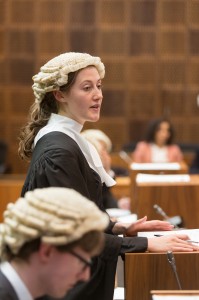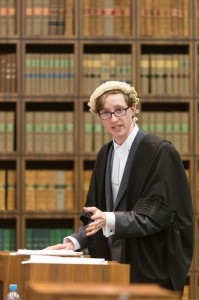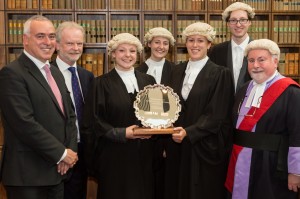
This past year I represented The City Law School, along with Philip Aspin, in the University of Hertfordshire/Blackstones National Criminal Advocacy Competition. In contrast to your traditional moot, where the focus is on points of law at an appellate level, the competition hones in on the practicalities of first-instance advocacy at the Criminal Bar. The experience was incredibly positive, providing a rare insight into what trial advocacy is like prior to commencement on the BPTC.
The competition was divided into two sections. The first consisted of two preliminary rounds. The second was the ‘Finals Weekend’, where the top ten scoring teams from the preliminary rounds are invited to a residential weekend at the University of Hertfordshire, and during which the quarter-finals, semi-finals and final all take place.
The first preliminary round required participants to deliver or oppose two pre-trial applications. There was a bad character application and a bail application. Having had experience of moots, for which you must prepare the relevant case law or legislation which supports your position and usually bundles for the judges as well, I felt comparatively footloose. All you needed to know was the procedural law governing the applications (in other words, what you could or could not apply for) and the facts of the case.
It was then a matter of persuading the judge that your position was correct. This may sound more straight-forward, but it shifted much more of the focus to one’s advocacy skills – eye contact, tone of voice, structure and content of submissions.

The second preliminary round consisted of a mock trial – with all the trimmings! This involved opening and closing speeches, examination-in-chief and cross-examination. The witnesses were willing friends and family. We had no prior experience, and I will admit that preparations for it mainly consisted of racking my brain for what I had seen on mini-pupillages and/or tv court-room dramas (although it should be noted that the competition guidelines are incredibly useful in setting out what to expect at each round). All I can say is that the best way to learn is through practice. I had a much better idea of how to structure my examination of witnesses, once I had experienced being utterly dumbfounded when a witness just will not say what you want them to.
The finals weekend really was an incredible experience. We arrived on the Friday and were given an advocacy training session with Mr. Kenneth Aylett from 4 Breams Buildings. This was a brilliant opportunity to hear gems of wisdom from a practitioner of 40 years call. The next morning we went straight into the quarter-finals, which in essence was a repeat of the two preliminary rounds. There was an added element of reality to this, as the result of the pre-trial applications would obviously affect what evidence could be used in the following trial.
The University of Hertfordshire offered incredible facilities for the competition. Most of the advocacy during the weekend took place in their ‘courtroom’ which was a very impressive model of a Crown Court courtroom, with a real dock, jury box, and witness stand. In fact, the room is so realistic that it was used for one of the episodes of Silk on BBC. We were given wigs and gowns to wear and there were court ushers who would monitor the runnings of the court.
It should be mentioned that teams are judged on a points-based system, rather than on a knock-out round. In fact, we progressed to the semis with both teams that we had competed against in the prior rounds, and this produced a very friendly atmosphere.
There was a dinner on the Saturday evening for all those taking part in the competition, during which we heard Sir Anthony Hooper give an insightful and passionate talk about the Legal Aid cuts. For the semi-finalists, it was then straight onto preparations for the next day – with a whole new set of case papers, and only an evening in which to prepare!

For the semi finals we delivered pre-trial applications in front of HHJ Bright QC, Lou Sharman JP Chair of the Hertfordshire Magistrates’ Association and Gavin Collett from Rougemont Chambers. There was an added layer of complexity to this as the applications which each team member gave were linked, meaning the success or failure of one would likely impact the other. We were very excited to hear that we were successful in reaching the final round, but this gave us roughly just over an hour to prepare for the trial.. The final was in front of HHJ Peter Murphy from Blackfriars Crown Court, Stuart Trimmer QC from 4 Breams Buildings and John Cooper QC from 25 Bedford Row. Although we came second, it was a brilliant experience (especially the chance to deliver a closing speech to a packed jury box). The winners were Joy Lewis and Sophie Warren-Evans from Nottingham Law School and it was very much deserved.
All in all, I am very grateful to have had the opportunity to take part in the competition. I cannot stress enough how much I learnt from the experience, and how much it inspired me to further pursue a career at the Bar. Special thanks should go to Emily Allbon for organising the City Law School team and to the supremely energetic Neal Geach from the University of Hertfordshire who organised the whole competition.
Many thanks to Merrow for writing up the experience! Merrow is currently a BPTC student at The City Law School, after completing her GELLB in June 2013.
Image credits: Pete Stevens
